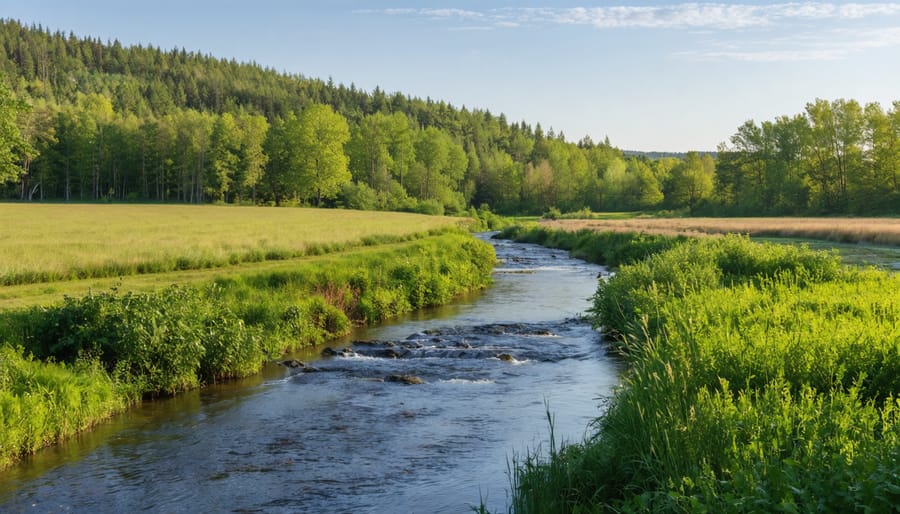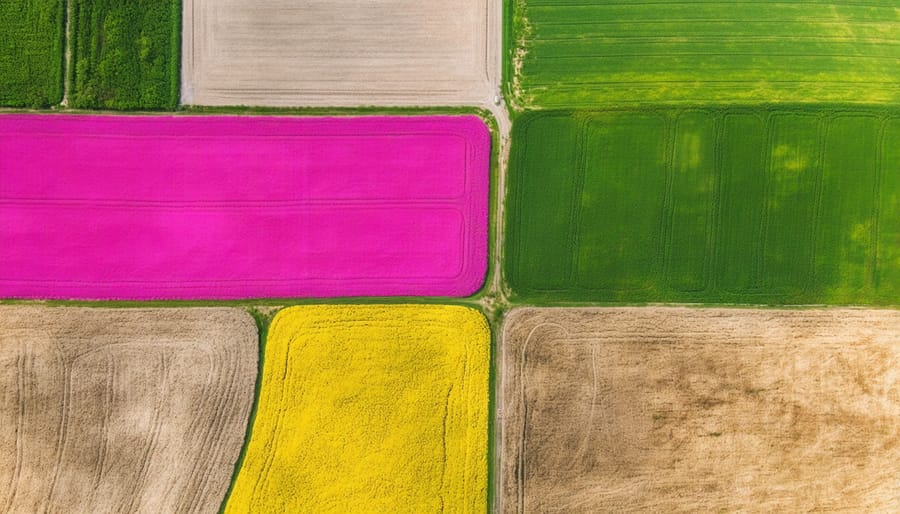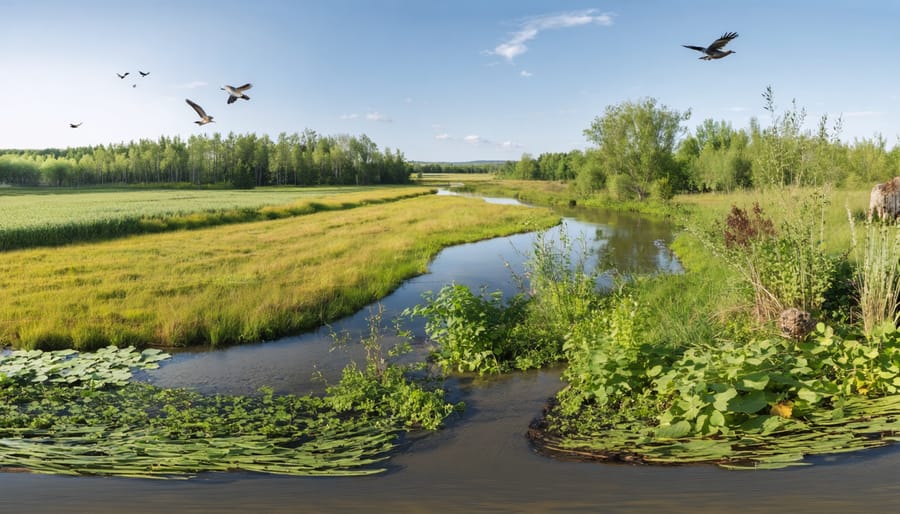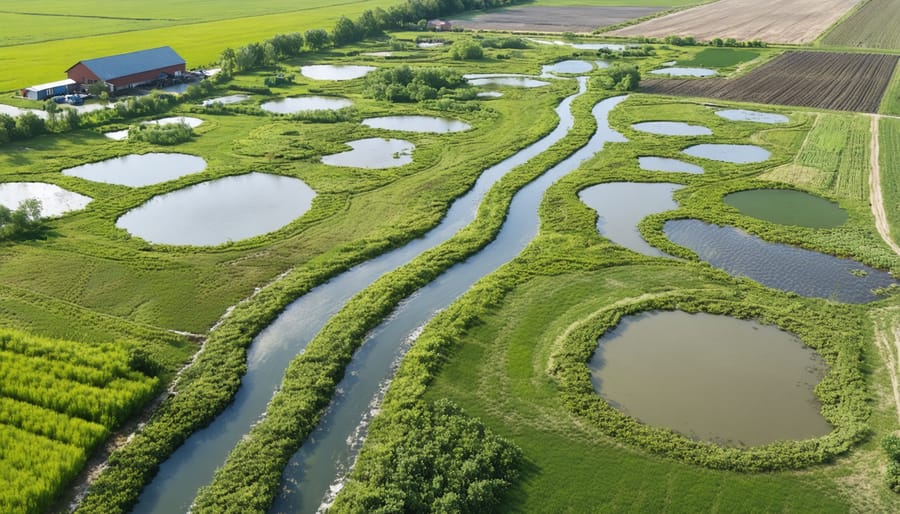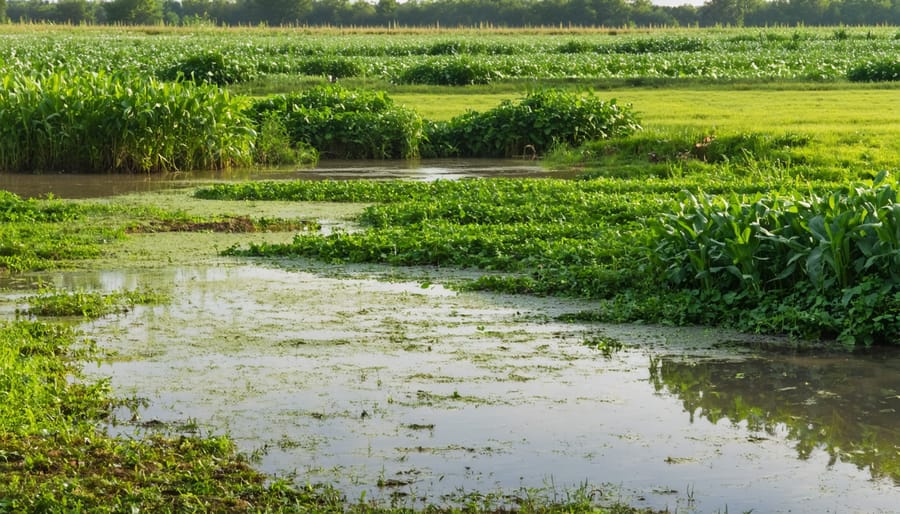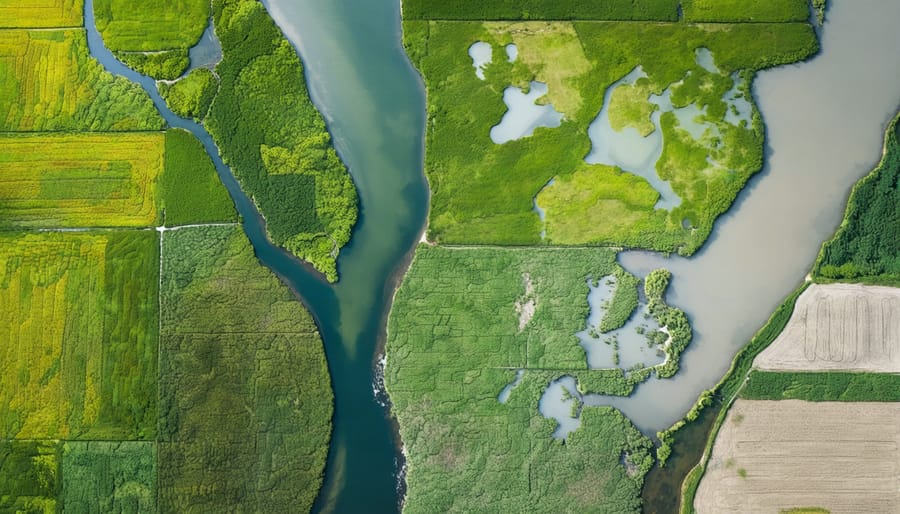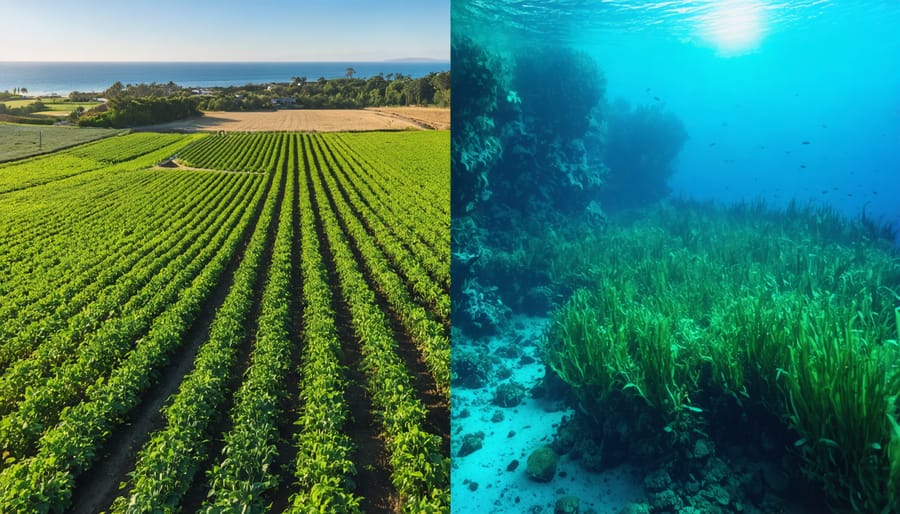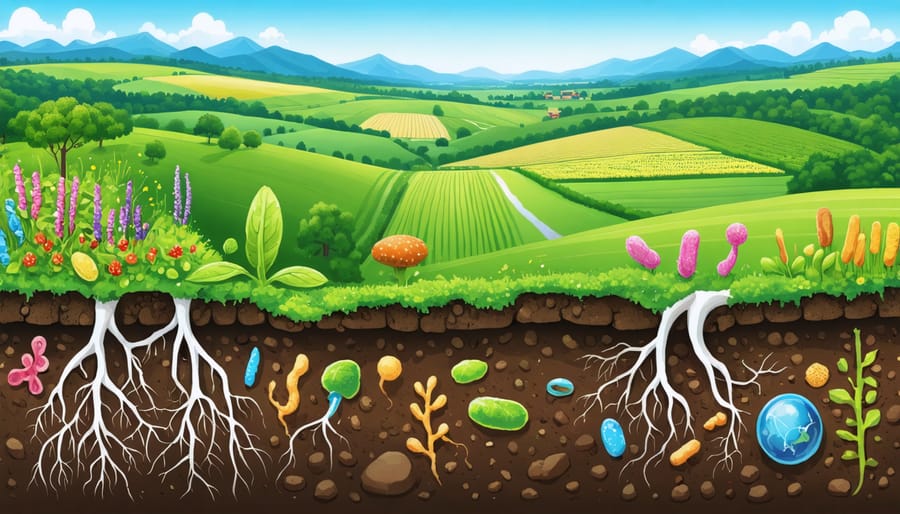Along the winding rivers and streams of Alberta’s agricultural landscape, riparian buffers stand as nature’s front-line defenders of water quality and ecosystem health. These vital strips of vegetation – ranging from grasses and shrubs to mature trees – create a living bridge between farmland and waterways, serving as both environmental guardians and agricultural assets. For Canadian farmers facing increasing pressure to balance productivity with sustainability, understanding riparian buffers isn’t just about environmental compliance; it’s about protecting their land’s long-term value and contributing to cleaner water resources across the province. Whether you’re managing a small acreage or operating a large-scale farming operation, implementing effective riparian buffers represents one of the most practical and powerful steps toward sustainable agriculture in our region. These natural filters not only protect water quality and prevent soil erosion but also create valuable wildlife habitat while enhancing farm productivity through improved soil stability and natural pest control.
What Makes a Riparian Buffer Work?
The Three-Zone Buffer System
The three-zone buffer system is widely recognized as the gold standard for riparian buffer design across Canadian farmland. This approach divides the buffer into three distinct areas, each serving unique purposes in protecting our waterways.
Zone 1, closest to the water, extends about 5-10 metres from the waterline and consists of undisturbed native trees and shrubs. This zone stabilizes the bank, provides shade, and creates essential wildlife habitat. In Alberta, species like willows and poplars are particularly effective here.
Zone 2, the middle section spanning 10-20 metres, typically includes managed forest or woodland. This area helps filter runoff, reduces erosion, and can provide sustainable wood products or berries when properly managed. Many Alberta farmers have successfully integrated saskatoon berries and other native species in this zone.
Zone 3, the outermost band measuring 6-12 metres, consists of tall grasses or perennial vegetation. This zone acts as the first line of defence, slowing water flow and filtering sediment from field runoff. It can also serve as a paddock or hay field, making it a practical transition between cropland and the more protected inner zones.
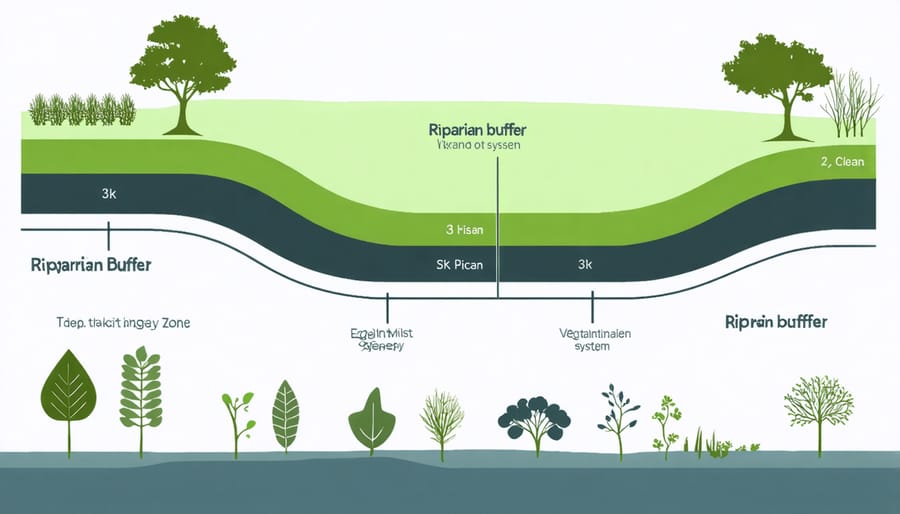
Optimal Width and Vegetation Types
For Alberta’s climate, effective riparian buffers typically range from 10 to 30 metres in width, though specific requirements vary based on slope, soil type, and water body characteristics. Wider buffers are recommended for steep terrain or areas prone to erosion, while gentler slopes may function well with narrower buffers.
The most effective buffers incorporate three distinct vegetation zones. The zone nearest the water should include native water plants and moisture-loving species like willows and water sedges. The middle zone thrives with trees such as trembling aspen, balsam poplar, and white spruce, which provide excellent soil stabilization. The outer zone, transitioning to farmland, works well with native grasses and flowering plants like rough fescue and wild bergamot.
For optimal year-round effectiveness, combine both deciduous and evergreen species. This mix ensures continuous root structure and soil protection even during winter months. Remember to select plants that are well-adapted to your local conditions and consider consulting with your local agricultural fieldman for site-specific recommendations.
Direct Benefits to Your Farm
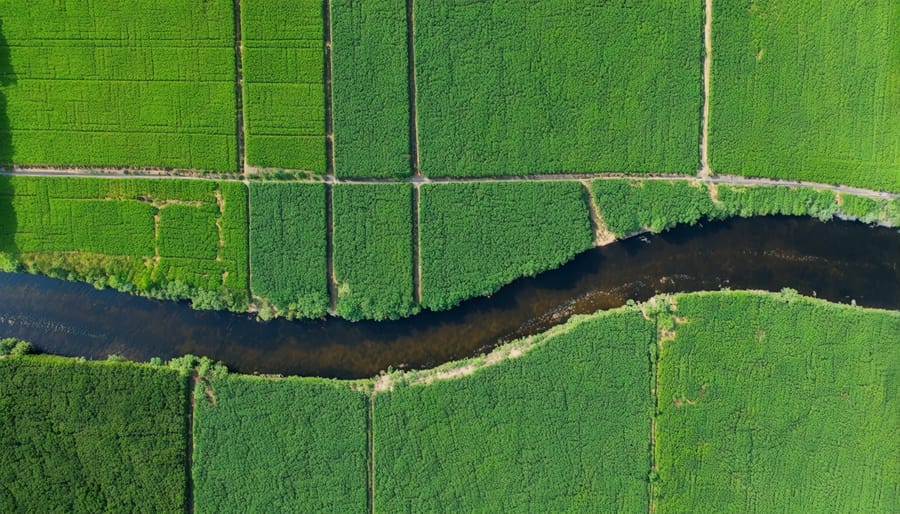
Soil Protection and Water Quality
Riparian buffers play a crucial role in protecting our waterways and maintaining soil health and strength. These natural barriers act like filters, catching and holding soil particles that would otherwise wash away during heavy rains or spring thaws. Here in Alberta, where we often face intense weather patterns, these buffers are especially important for preventing soil erosion along creek banks and river edges.
The deep-rooted vegetation in riparian zones creates a strong network that holds soil in place, while the above-ground plants slow down water flow during rain events. This simple but effective system can reduce soil loss by up to 80% compared to unprotected banks. When it comes to water quality, these buffers excel at filtering out agricultural nutrients like nitrogen and phosphorus from field runoff before they reach our waterways.
Think of riparian buffers as your land’s natural kidneys – they trap sediments, absorb excess nutrients, and break down many agricultural chemicals before they can impact water quality. For Alberta farmers, this means reduced nutrient loss from fields and better compliance with water quality regulations. The buffer vegetation also helps capture and filter snowmelt in spring, preventing sudden erosion events that can damage valuable farmland.
By maintaining healthy riparian buffers, you’re not just protecting your soil – you’re safeguarding water quality for your entire community and downstream users.
Wildlife Habitat and Biodiversity
Riparian buffers serve as vital corridors for wildlife, creating diverse habitats that support numerous species while enhancing farm resilience through biodiversity. In Alberta’s agricultural landscapes, these buffer zones provide essential shelter, breeding grounds, and food sources for native birds, small mammals, beneficial insects, and amphibians.
The multi-layered vegetation structure typical of riparian buffers – from ground cover to shrubs and trees – creates multiple habitat niches. Birds like Western Meadowlarks and Mountain Bluebirds use these areas for nesting, while beneficial insects such as lady beetles and parasitic wasps find refuge here, naturally controlling crop pests on adjacent farmland.
These buffer zones also act as wildlife corridors, allowing animals to move safely between larger habitat patches. This connectivity is particularly important in fragmented agricultural landscapes, helping maintain genetic diversity among wildlife populations. During harsh Prairie winters, these areas provide critical shelter for many species, including white-tailed deer and various songbirds.
For farmers, this increased biodiversity translates to practical benefits. Natural pest control services provided by insectivorous birds and beneficial insects can significantly reduce the need for chemical pesticides. Additionally, the presence of pollinators supported by riparian vegetation can improve crop yields in nearby fields, particularly for canola and other pollinator-dependent crops common in Alberta.
Implementation Success Stories
Local Farm Spotlight
Tom Anderson, a third-generation farmer from Lacombe County, has been maintaining riparian buffers on his 800-hectare mixed farm for over 15 years. “When we first started implementing buffer zones along our creek, I wasn’t sure what to expect,” Tom shares. “Now, I wouldn’t farm any other way.”
Tom’s buffer zones extend 30 metres from the creek edge and include a mix of native grasses, willows, and white spruce. He’s noticed significant improvements in bank stability and water quality since establishing these areas. “The difference is night and day,” he explains. “During the 2019 floods, our protected creek banks held firm while neighboring properties suffered severe erosion.”
The Andersons worked closely with their local watershed stewardship group to design their buffer system, incorporating both woody vegetation and grassland areas. This approach has created valuable wildlife habitat while protecting their cropland. “We’ve seen everything from deer to northern pintails using these areas,” says Tom’s daughter Sarah, who helps manage the farm.
The family has also noticed economic benefits. “Our buffer zones act as natural snow fences in winter, helping with moisture retention,” Tom notes. “Plus, we’ve reduced our equipment and fertilizer costs since we’re not fighting erosion anymore.”
Tom’s advice to other farmers? “Start small, but start somewhere. The long-term benefits far outweigh any initial challenges.”

Cost-Benefit Analysis
Based on a 2022 study of Alberta farms, implementing a 30-metre riparian buffer typically costs between $2,000 and $3,500 per hectare, including site preparation, plant materials, and initial maintenance. However, the financial returns often outweigh these initial investments. Local farmers report saving $800-1,200 annually in reduced erosion control measures and decreased soil loss.
The Alberta Agricultural Carbon Offset Program offers compensation of up to $30 per acre for established riparian buffers, helping offset implementation costs. Additional benefits include increased property values, with real estate assessments showing 5-15% higher valuations for farms with well-maintained riparian areas.
Dave Johnson, a cattle farmer near Red Deer, shares that his buffer zone investment paid for itself within four years through reduced feed costs and improved herd health. His cattle now benefit from better water quality, resulting in 12% fewer veterinary visits annually.
Environmental grants and cost-sharing programs through local watershed groups can cover up to 75% of establishment costs, making buffer implementation more financially accessible for Alberta farmers.
Getting Started with Buffer Zones
Getting started with riparian buffers doesn’t have to be overwhelming. Begin by assessing your land and identifying waterways that would benefit from protection. Walk your property during both wet and dry seasons to understand water flow patterns and potential erosion concerns.
Start with a simple sketch of your property, marking existing natural vegetation and areas where you’d like to establish new buffer zones. The recommended width for most Alberta farms is 10 to 30 metres, but even smaller buffers can make a difference. Consider your specific goals – whether it’s reducing erosion, improving water quality, or creating wildlife habitat.
Choose native plants that suit your local climate and soil conditions. In Alberta, popular choices include white spruce, trembling aspen, and various willow species. For the best results, plant in layers: trees along the outer edge, shrubs in the middle, and grasses or sedges nearest the water.
Contact your local agricultural fieldman or conservation authority for guidance. Many regions offer cost-sharing programs and technical support for buffer establishment. Don’t forget to check local regulations and obtain necessary permits before starting your project.
Remember, you don’t need to establish your entire buffer system at once. Start with a manageable section and expand gradually. This approach allows you to learn from experience and adjust your strategies as needed, while keeping costs and labour requirements reasonable.
Establishing riparian buffers is more than just an environmental practice – it’s an investment in the future of Alberta’s agricultural landscape. These natural barriers protect our waterways, enhance biodiversity, and contribute to sustainable farming operations. By implementing buffer zones of 30 to 50 metres along waterways, farmers can significantly reduce soil erosion, improve water quality, and create valuable wildlife corridors. The benefits extend beyond individual farms to support our entire agricultural community and ecosystem health. As stewards of the land, we have the opportunity to make a lasting positive impact. Consider starting with a small section of your property and gradually expanding your buffer zones. Connect with local agricultural extension offices and fellow farmers who have successfully implemented these practices. Together, we can protect our water resources while maintaining productive and profitable farming operations for generations to come.

